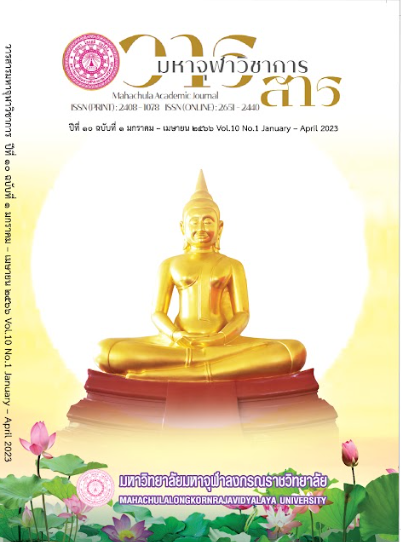Life Metaphor in Dhrama Discourse in Facebook Page “Phra Sakda Suntaro”
Main Article Content
Abstract
This research aims to present about the study of life metaphors in Dharma context released on Facebook page named “Phra Sakda Suntaroo” owned by Phra khru Sakkarak Sakda Suntaro. The descriptive research technique is applied to use with conceptual metaphor to be emphasis with in linguistics. The data is in the form of the video clips posted on a social media named Facebook as mentioned earlier. The duration of the data collection is from 1st January 2020 to 31st December 2021. The spoken words were all transcripted and recorded in 482 clips with the length of 20 hours and thirty minutes in total.
The research found that the Dharma context found in Facebook “Phra Sakda Suntaro” illustrates a great deal about the life metaphors. They appear in 8 categories as follows; (1) life is a journey, (2) life is a fighting, (3) life is an investment, (4) life is a growth of trees, (5) life is a theatre, (6) life is a learning, (7) life is a prisoner, (8) life is a weapon. The usage of the metaphor illustrates the uncertainty in life. It can move forward or backward as the way it is. Life is full of fighting, suffering with enormous pain and gain. The experiences always attach with high price. Though the endurance in human life comes with its limitation so that hectic can lead to chaotic then finally human’s life can end up like a prisoner who was pushed to accept the death penalty.
Article Details

This work is licensed under a Creative Commons Attribution-NonCommercial-NoDerivatives 4.0 International License.
References
จักริน ฉัตรไชยพฤกษ์ และเขมฤทัย บุญวรรณ. “โครงสร้างปริจเฉท และกลวิธีทางภาษาในการสนทนาระหว่างคู่สนทนาที่ไม่รู้จักกันในรายการ “ต่อปาก ต่อคำ ติดไฟแดง”. The Liberal Arts Journal Faculty of Liberal Arts, Mahidol University. ปีที่ ๒ ฉบับที่ ๒ (กรกฎาคม - ธันวาคม) : ๔๗ – ๗๓.
ชัชวิน วรปัญญาภา. “การเปลี่ยนแปลงสถานะของศาสนาพุทธในประเทศไทยภายหลังการเปลี่ยนผ่านอำนาจทางการเมือง”. รายงานการประชุมวิชาการสาขานิติศาสตร์ระดับชาติครั้งที่ ๑ หัวข้อ “ระบบกฎหมายไทย : ปฏิรูป / เปลี่ยนผ่าน/ ปฏิสังขรณ์”. (๘ มิถุนายน ๒๕๖๑) : ๒๑๗ - ๒๓๔.
ไตรทิพย์สุดา เสนาธรรม และศันสนีย์ เอกอัจฉริยา. “มโนอุปลักษณ์ [หน้า] ในสำนวนจีน”. วารสารจีนศึกษามหาวิทยาลัยเกษตรศาสตร์. ปีที่ ๑๒ ฉบับที่ ๑ (มกราคม – มิถุนายน, ๒๕๖๒) : ๔๗-๖๙.
ทวีศักดิ์ ทองทิพย์, ชนิศร์ ชูเลื่อน, พระใบฎีกาสุพจน์ ตปสีโล, สหัทยา วิเศษ, และธนู ศรีทอง. “ภูมิศาสตร์วัฒนธรรม : ประวัติศาสตร์ เส้นทางการเผยแผ่พระพุทธศาสนาและหลักพุทธธรรมในประเทศไทย”. วารสารมนุษยศาสตร์และสังคมศาสตร์ มหาวิทยาลัยราชภัฏสุรินทร์. ปีที่ ๒๑ ฉบับที่ ๒ (กรกฎาคม-ธันวาคม ๒๕๖๒) : ๘๙-๑๐๐.
ธนณ์พรรศดิ์ แก้วประดิษฐ์พร. “มโนอุปลักษณ์ในข่าวบันเทิงบนเว็บไซต์หนังสือพิมพ์ออนไลน์”. วิทยานิพนธ์อักษรศาสตรมหาบัณฑิต. บัณฑิตวิทยาลัย: มหาวิทยาลัยศิลปากร, ๒๕๖๓.
ปิยภรณ์ อบแพทย์. “อุปลักษณ์เกี่ยวกับชีวิตในหนังสือธรรมะ”. วิทยานิพนธ์อักษรศาสตรมหาบัณฑิต. บัณฑิตวิทยาลัย: จุฬาลงกรณ์มหาวิทยาลัย, ๒๕๕๒.
พระครูปลัดสุวัฑฒนพรหมจริยคุณ (คำมาก). “พระพุทธศาสนากับการพัฒนาทางการเมืองการปกครองในสังคมไทย”. วารสารปัญญาปณิธาน. ปีที่ ๕ ฉบับที่ ๑ (มกราคม – มิถุนายน ๒๕๖๓) : ๑-๑๔.
รัตนา จันทร์เทาว์, “อุปลักษณ์ผู้ชายและผู้หญิงในสุภาษิตบ่าวสาวลาว”. วารสารภาษา ศาสนา และวัฒนธรรม. ปีที่ ๗ ฉบับที่ ๑ (มกราคม - มิถุนายน ๒๕๖๑) : ๑๕๔-๑๘๓.
ศุภชัย ต๊ะวิขัย, “สถานภาพงานวิจัยอุปลักษณ์เชิงมโนทัศน์ในภาษาไทย”. วารสารอักษรศาสตร์ มหาวิทยาลัยศิลปากร. ปีที่ ๔๐ ฉบับที่ ๒ (กรกฎาคม - ธันวาคม, ๒๕๖๑) : ๒๐๒ - ๒๕๔.
สิริมา เชียงเชาว์ไว. “อุปลักษณ์เกี่ยวกับธรรมะในปาฐกถาธรรมของพุทธทาสภิกขุ”. วิทยานิพนธ์อักษรศาสตรดุษฎีบัณฑิต. บัณฑิตวิทยาลัย: มหาวิทยาลัยศิลปากร, ๒๕๕๖.
Lakoff, J.& Johnson, M. Metaphors We Live By. Chicago: The University of Chicago Press, 1980.
พจนานุกรม ฉบับราชบัณฑิตยสถาน. ๒๕๕๔. [ออนไลน์]. แหล่งที่มา: https://dictionary.orst.go.th/[๒๔กรกฎาคม ๒๕๖๕].


